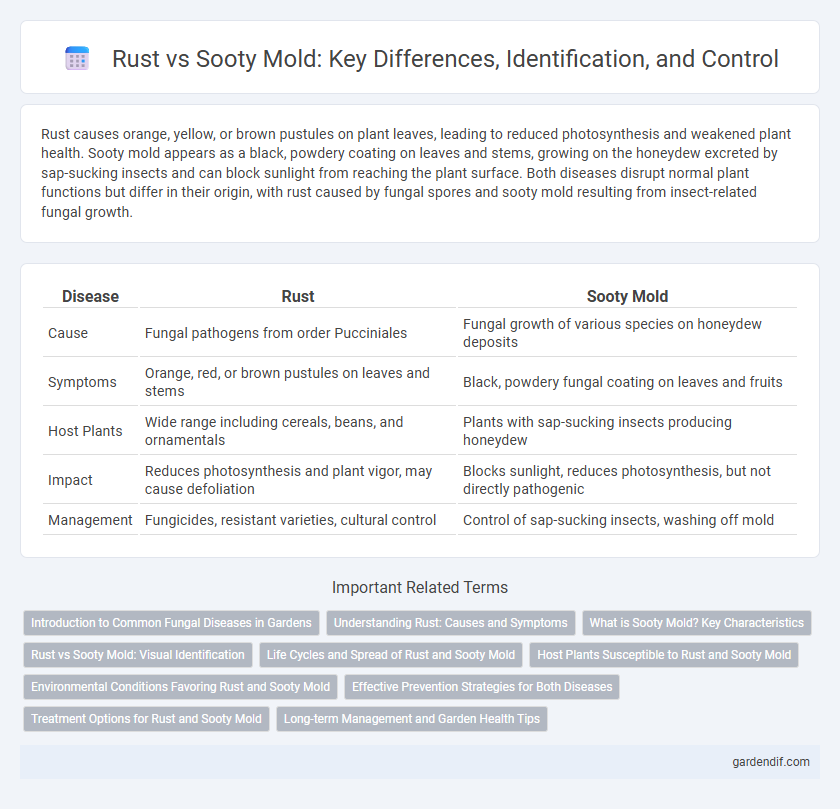
Rust vs Sooty mold Illustration
Rust causes orange, yellow, or brown pustules on plant leaves, leading to reduced photosynthesis and weakened plant health. Sooty mold appears as a black, powdery coating on leaves and stems, growing on the honeydew excreted by sap-sucking insects and can block sunlight from reaching the plant surface. Both diseases disrupt normal plant functions but differ in their origin, with rust caused by fungal spores and sooty mold resulting from insect-related fungal growth.
Table of Comparison
| Disease | Rust | Sooty Mold |
|---|---|---|
| Cause | Fungal pathogens from order Pucciniales | Fungal growth of various species on honeydew deposits |
| Symptoms | Orange, red, or brown pustules on leaves and stems | Black, powdery fungal coating on leaves and fruits |
| Host Plants | Wide range including cereals, beans, and ornamentals | Plants with sap-sucking insects producing honeydew |
| Impact | Reduces photosynthesis and plant vigor, may cause defoliation | Blocks sunlight, reduces photosynthesis, but not directly pathogenic |
| Management | Fungicides, resistant varieties, cultural control | Control of sap-sucking insects, washing off mold |
Introduction to Common Fungal Diseases in Gardens
Rust and sooty mold are prevalent fungal diseases affecting garden plants, each characterized by distinct symptoms and impacts. Rust typically appears as orange or reddish powdery pustules on leaves, reducing photosynthesis and plant vigor, while sooty mold manifests as a black, sooty coating on leaf surfaces, often growing on honeydew secreted by sap-sucking insects. Managing these diseases involves improving air circulation, removing infected plant parts, and applying appropriate fungicides tailored to the fungal species involved.
Understanding Rust: Causes and Symptoms
Rust is a fungal disease caused by pathogens in the Puccinia genus, characterized by orange, yellow, or brown pustules on the undersides of leaves. It disrupts photosynthesis by damaging leaf tissue, leading to premature leaf drop and reduced plant vigor. Early symptoms include small, discolored spots that expand into raised, powdery lesions distinguishing rust from sooty mold, which appears as a black, sooty coating on leaf surfaces without directly injuring plant cells.
What is Sooty Mold? Key Characteristics
Sooty mold is a fungal disease characterized by a black, powdery coating that develops on the surface of leaves, stems, and fruits due to the growth of fungal spores on plant exudates like honeydew. This mold does not directly infect plant tissues but inhibits photosynthesis by blocking sunlight, leading to reduced plant vigor and yield. Key characteristics include its easily recognizable black discoloration and its association with insect infestations such as aphids, whiteflies, and scale insects that produce the sugary secretions needed for mold growth.
Rust vs Sooty Mold: Visual Identification
Rust appears as powdery, orange to reddish-brown pustules primarily on the undersides of leaves, often causing yellow spots on the upper leaf surfaces. Sooty mold manifests as a black, powdery coating on leaf surfaces, stems, and fruits, growing on the honeydew secreted by sap-feeding insects. While rust damages plant tissue directly, sooty mold is superficial and inhibits photosynthesis by blocking sunlight.
Life Cycles and Spread of Rust and Sooty Mold
Rust fungi undergo a complex life cycle involving multiple spore stages, often requiring alternate host plants to complete their development and spread via wind-borne urediniospores. Sooty mold fungi grow superficially on plant surfaces, thriving on honeydew secreted by sap-sucking insects, with their spores disseminated primarily through air currents and rain splash. Rust infections penetrate host tissues intracellularly, whereas sooty mold remains epiphytic, affecting photosynthesis by coating leaves without directly invading plant cells.
Host Plants Susceptible to Rust and Sooty Mold
Rust primarily affects a wide range of host plants including cereals like wheat and barley, legumes such as peas and beans, and ornamental plants like roses and hollyhocks. Sooty mold commonly colonizes plants with honeydew-producing insects, impacting species such as citrus, lilac, and various fruit trees. Both diseases reduce photosynthesis and overall plant vigor but target different plant hosts based on their biological interactions.
Environmental Conditions Favoring Rust and Sooty Mold
Rust diseases thrive in warm, moist environments with temperatures between 50degF and 80degF and frequent leaf wetness for spore germination. Sooty mold development is favored by humid conditions and the presence of honeydew excreted by sap-sucking insects like aphids and whiteflies. Both fungi require specific environmental conditions that influence their proliferation and impact on plant health.
Effective Prevention Strategies for Both Diseases
Rust and sooty mold diseases require tailored prevention strategies to effectively protect plants. For rust, applying resistant plant varieties and maintaining proper spacing improves airflow, reducing moisture buildup that fosters fungal growth. Preventing sooty mold involves controlling insect pests like aphids and scale insects that excrete honeydew, the primary food source for the mold, along with regular cleaning of affected plant surfaces.
Treatment Options for Rust and Sooty Mold
Effective treatment options for rust include the application of fungicides containing chlorothalonil or myclobutanil, along with proper pruning to enhance air circulation and reduce humidity levels that favor pathogen development. Sooty mold management primarily involves controlling the underlying insect infestations such as aphids, whiteflies, or scale insects through insecticidal soaps or horticultural oils, as well as regular washing of affected plant surfaces to remove mold residues. Integrated pest management strategies are essential for both diseases to ensure long-term plant health and prevent recurrence.
Long-term Management and Garden Health Tips
Rust and sooty mold require distinctive long-term management strategies to maintain garden health effectively. Rust, a fungal disease, thrives in humid conditions and benefits from regular pruning and fungicide applications to reduce spore spread, while sooty mold, caused by fungal growth on insect honeydew, improves with pest control practices targeting aphids and scale insects. Maintaining proper air circulation, avoiding overhead watering, and ensuring balanced fertilization further minimize conditions favorable for both diseases, promoting sustained plant vigor and garden resilience.
Rust vs Sooty mold Infographic

 gardendif.com
gardendif.com